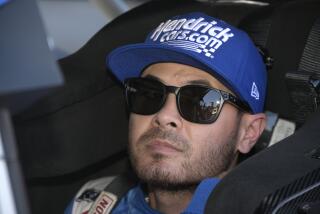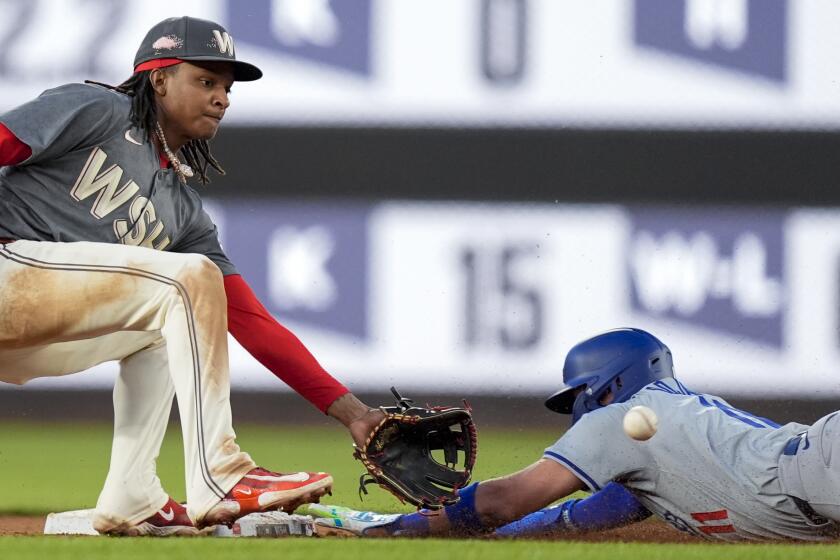Should NASCAR reconsider restrictor-plate racing?
In the aftermath of Saturday’s crash at Daytona International Raceway, writers from around the Tribune Co. discuss whether NASCAR should reconsider restrictor-plate racing for safety reasons. Feel free to join the conversation with a comment of your own.
Jim Peltz, Los Angeles Times
After finishing third in the Daytona 500, Mark Martin addressed the NASCAR Nationwide Series crash a day earlier that injured spectators when they were hit by flying debris. That outcome, he said, “is something that we cannot have happen.”
Despite Martin’s good intentions, no race is 100% safe for fans, hence the fine legal print on the back of their tickets. But there also is no reason NASCAR cannot revisit its guidelines for restrictor-plate racing at Daytona and Talladega. Don’t discard it -- the crash that ushered in this type of racing, Bobby Allison’s at Talladega in 1987, showed speeds needed to be capped.
But there might be other rules or car adjustments that could reduce the risk. The tracks also should re-examine their fencing and seating. Moving the lowest seats higher would not eliminate the potential for injury, as was seen Saturday, but it might put more fans out of harm’s way.
George Diaz, Chicago Tribune
There is risk in every sport.
NASCAR carries an inherent danger for both drivers and spectators. Restrictor-plate racing always brings that X-factor.
What happened at Daytona on Saturday was frightening, but the fact remains that tens of thousands of fans came back Sunday to watch another race in which drivers drove at even faster speeds.
Race horses are put down after accidents, a tragic parade of former NFL players is dealing with bad concussion-related symptoms, and generations of former boxers have been declared punch-drunk .
A freaky thing happened Saturday, but it is not the norm for every race. What usually happens is that cars go flying, and drivers remarkably walk out of the carnage relatively unscathed. That’s what Kyle Larson did after his car was ripped to shreds on Saturday.
The nanny state seems to have forgotten that point.
Kevin Cowherd, Baltimore Sun
The gripe about restrictor plates is that they cause pack racing, which can make a race like the Daytona 500 look like rush hour on the beltway, with a mass of cars running bumper to bumper. Owners don’t like it, drivers don’t like it, fans don’t like it. But without restrictor plates limiting speeds, cars can take flight and land in the grandstands and do even more damage than the crash that injured 28 spectators at Daytona on Saturday. So don’t look for the plates to go away soon.
It’s more likely NASCAR will look into making catch fences higher and more curled at the top. There’s even talk of replacing the fences with thick, clear plastic walls to prevent cars from getting torn into pieces when they’re airborne. That might be the best move of all.
Keith Groller, Allentown Morning Call
While not hitting the panic button, this needs to be studied before another driver or a fan gets killed. Restrictor-plate racing, originally designed as a safety measure to slow cars down, defeats its own purpose. It leads to bunched-up racing because cars are less capable of gaining separation. That means you’ll get tight situations like the one on the final lap of the Nationwide race on Saturday at Daytona. Notice most of the sport’s more horrific crashes are on restrictor-plate tracks and usually come late when drivers attempt bold moves.
On one hand, three-wide races to the finish are what the sport is all about. And danger is part of the sport’s lifeblood. But NASCAR must find a balance between what the fans want and what is best for those closest to the action.
ALSO:
Photos: Nationwide Series crash at Daytona
Jimmie Johnson has more at the finish, wins Daytona 500
NASCAR crash sends pieces of car into stands, injuring spectators
More to Read
Get our high school sports newsletter
Prep Rally is devoted to the SoCal high school sports experience, bringing you scores, stories and a behind-the-scenes look at what makes prep sports so popular.
You may occasionally receive promotional content from the Los Angeles Times.






